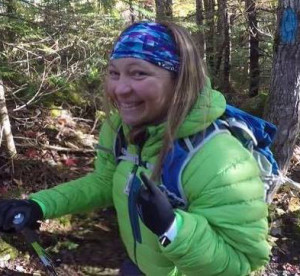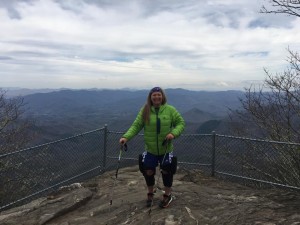 Now 41, Stacey Kozel was diagnosed with lupus when she was 19 years old. Lupus is a chronic autoimmune disease that can damage any part of the body. The symptoms for Stacey, as for some other Lupus patients, has been cyclical, every couple of years she would have a “flare-up”.
Now 41, Stacey Kozel was diagnosed with lupus when she was 19 years old. Lupus is a chronic autoimmune disease that can damage any part of the body. The symptoms for Stacey, as for some other Lupus patients, has been cyclical, every couple of years she would have a “flare-up”.
The disease directly attacked her central nervous system during each flare-up, causing her to lose muscle function. In March 2014 she lost all mobility, couldn’t sit up or lift her head. With determination, she slowly recovered control of both arms and her upper body, but her legs were paralyzed. Her mobility depended upon her electric wheelchair.
“I’ve always wanted to hike, but just I felt like I was trapped in my wheelchair. I was just dying to get outside.” (www.today.com/health)
She searched the Web for anything that could help and found the Ottobock C-Brace. The Ottobock C-brace is a bionic leg brace, computer controlled, functioning like a mechanical exoskeleton. The brace cups around the foot, extends up the thigh and has bendable knee joints equipped with sensors that constantly measure the position of the joint. There is also a carbon/fiberglass spring with a sensor to monitor ankle pressure.
 Stacey realized she was a long way from qualifying for the brace because she needed more core and upper body strength than she had. She focused hard on her rehab with her physical and occupational therapists and months later gained enough strength in her core and upper body to figure out ways to compensate for parts of her body that would not cooperate. She would be able to qualify for the C-brace – but ran into another problem – the price tag of $75,000.
Stacey realized she was a long way from qualifying for the brace because she needed more core and upper body strength than she had. She focused hard on her rehab with her physical and occupational therapists and months later gained enough strength in her core and upper body to figure out ways to compensate for parts of her body that would not cooperate. She would be able to qualify for the C-brace – but ran into another problem – the price tag of $75,000.
She thought about how she could reduce her muscle tightness, sores and skin breakdown by not having to sit all day and how she would be able to walk into restaurants and visit places she couldn’t. But her insurance company said the quality of life she was looking for was “not necessary”. Stacey kept sending appeals and one after another they were denied.
“It felt like they had control of my life. They could just approve me, and there would be so many more possibilities [in my life]. Every denial was very hard…It was depressing” (Washington Post)
She didn’t stop appealing the decisions, though, and a year later, she was finally approved.
Stacey quickly adjusted to the braces, walking easily around the house, then the block, then the neighborhood. Then she decided to hike the Appalachian Trail.
“My goal is to bring awareness to these braces so people know they exist and hopefully it gives more people the ability to get out of their wheelchairs and out exploring the world. There are people that qualify for these braces that either do not know they exist or it gets stopped with an insurance denial. I hope WHEN I make it back to Mt. Katahdin on my thru hike, insurance companies will have a much tougher time telling others that the braces are “not necessary.” (Appalachian Trials)
She began her hike, solo, in March 2016, finding many friends along the way.
“You’re never alone out here. You have a trail family, they call it,” she said. “For me, I’m slower, so we end up finishing the day in the same area, but it just takes me a lot more hours. You end up hiking with the same group of people.” (Washington Post)
“It’s not going to be pretty and it’s not going to be fast, but I’ll get there.” (today.com)
Along the way, Stacey has learned the limitations of the C-Brace. When she faces boulders and steep inclines or embankments, she’ll throw her backpack ahead. Then she’ll sit and pull herself up backwards, scooting along. They also can’t get wet, and they require a new charge every two days. That’s where the “trail angels” come in, people who live along the trail and allow hikers to stop in for a night’s rest, a warm meal or, in Kozel’s case, a charge.
I am hoping when people see me out there hiking it gives them hope, and no matter how challenging their life may seem they continue to fight for their goals/dreams and never give up! There are always going to be people out there to raise doubt and tell others what they can/cannot do, but the only one that truly knows our body is ourself… We never know what we can accomplish if we give up too soon! (appalachiantrials.com blog)
Stacey passed the halfway point in July. Her determination has earned her a nickname among the hikers on the trail: Ironwill. She is journaling her hike on her Facebook page – https://www.facebook.com/ATIronwill
Here’s an excerpt from a recent update: September 1 at 4:42pm ·
This was definitely the toughest week on the trail for me. I got off trail in Vermont and headed to Maine in hopes to get to the summit on Mt Katahdin before weather starts to get bad and then hike southbound to where I left off in Vermont (called a flip flop for my non hiking friends)… My braces do not actually help me get up the mountain (especially a mountain like Katahdin) but when they are not working it feels like I strapped cement around my legs and decided to climb the mountain. This is NOT the mountain to strap cement around your legs! ? I was so slow up and down the mountain that I am pretty sure I was hiking in place (at least that’s what my fit bit seemed to tell me! ?). In fact, I was so slow it was considered “camping” and I got a written citation warning by the park…now that’s slow!? It was a bad week but I will NEVER give up! The worst day on the trail is still WAY better than the best day in the hospital!! .. I’m back in Ohio now to try to get my braces fixed and recuperate a bit before getting back on the trail.
We’re with you in spirit Stacey! Happy Trails on the rest of your journey!

